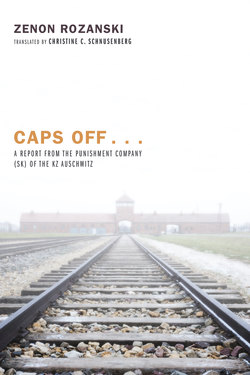Читать книгу Caps Off . . . - Zenon Rozanski - Страница 8
На сайте Литреса книга снята с продажи.
Introduction
ОглавлениеAuschwitz: Extermination Camp. Ramp. Selection. Zyklon B.
Auschwitz was, however, also a Labor Camp. Hunger, anguish, threats, fear, death were awaiting those who seemed fit for work to the examining physician either in the camp or on the ramp. From the beginning, it was planned to exterminate the Jews by way of labor. It was, however, intended to utilize their energy reserves for the SS State; about three to four months were anticipated as the time frame of their work. In 1942, the maximal life span of the Jews in Auschwitz amounted to six months. Jews were already being transported to Auschwitz in 1941. However, Auschwitz was originally designated as a Concentration Camp (KZ) for Polish resistance fighters, intellectuals, and other Poles who appeared to be dangerous to the National Socialist regime. A former Austrian army barrack existed in a sparsely populated area south of Kattowitz with favorable connections to the Polish railroad network which had intermittently been utilized by the German Army.
The SS considered this location an excellent one. Therefore, in August 1941, in Berlin, Himmler gave his infamous order to the first KZ commander, Rudolf Hoess, to expand the Camp of Auschwitz for the extermination of European Jews. At the Wannsee Conference of January 20, 1942, the logistics for the extermination were clarified.
In addition to Auschwitz, there were five other large extermination camps. They were built between 1941 and 1942 and began operating around the middle of 1942. These were the camps of Belzec, Sobibor, Treblinka, Lublin (Majdanek), and Kulmhof (Chelmo). Even today, they can be found on maps because they bear the names of the cities which were located in their vicinity.
When the first camp, which was later called Base Camp Auschwitz I, was no longer sufficient, the Camp Birkenau (Auschwitz II) was built. It was three kilometers away from Auschwitz I. This part began operating in 1942, and in 1943 it was made the largest extermination center of all times. Here, more than 1,000,000 Jews were murdered.
The Camp of Birkenau for women prisoners consisted almost entirely of so-called horse stable barracks. In that place, the conditions were like the ones that Zenon Rozanski described for Block 7 of the camp for men at Birkenau.
From his position as a prisoner in the Punishment Company (SK), Zenon Rozanski was never able to obtain a comprehensive overview of the conditions in the KZ Auschwitz. Therefore, we strongly recommend that our readers also read the books by the Secretary of the Comité Internationale des Camps, Hermann Langbein. The titles are listed in the Appendix.
The colors in the left-hand corners of their chests made it possible to determine to which particular group the prisoners belonged. Through these colors, as well as the numbers which were tattooed into the skin of the left forearms and later fixed unto the clothes, the prisoners—in the eyes of the SS—ceased to exist as persons. The green ones, the BVs (Befristete Vorbeugungshäftlinge), were officially “restricted prisoners in preventive custody”; unofficially, they were habitual criminals. These were most often the worst prisoners and were frequently as brutal as the SS. However, even among those, there were exceptions. The red corner, on the other hand, designated political prisoners, thus, also Zenon Rozanski, the journalist from Warsaw. Many BVs (green ones) rendered great service to their comrades. Eugen Kogon describes in his book Der SS-Staat the fights between the red and green ones for predominance in the camps. The fate of thousands of individuals sometimes depended on who would be the winner.
I read Rozanski’s report, as it is now before us, for the first time as a young man during the 1950s. My interest in the debate about the crimes of the NS regime was sparked by discussions in the home of my parents.
Later, I tried to research the biography of Rozanski after the collapse of the National Socialist regime. However, it was already too late. His traces are lost in Brazil. My research, which I conducted with the help of many authorities and individuals, came to an end in the 1970s. The present book is the only one which Rozanski wrote. It was published for the first time in 1948 by the Fritz Küster Verlag in Hannover. Although it was printed on paper of poor quality, it appeared in a relatively high edition. Its reception was probably minimal during the bad times of the post-war years. That was certainly the case during the better times at the beginning of the Wirtschaftswunder (economic miracle), when the SS-State was a matter of only the recent past. At that time, the repression of the earlier period was achieved almost to perfection. It was not until the Auschwitz Trial in Frankfurt during the years of 1963 through 1965 that there was a growing awareness of the crimes in the German concentration camps and, consequently, an increased readiness to confront these facts.
Today, as at that time, we hear the opinion expressed that the past events should finally be put to rest. The growing of the extreme right in the German Federal Republic must be stemmed. However, the repression has to be balanced against the reports, books and lectures of former KZ prisoners so that the truth can time and again pave the way. The new edition of the work Mützen ab . . . , published by the Fritz Küster–Archiv of the University of Oldenburg ought to be perceived in this sense. I wish this book a wide circulation, especially among young readers.
Dr. Med. Winfried Oster
Herdecke
